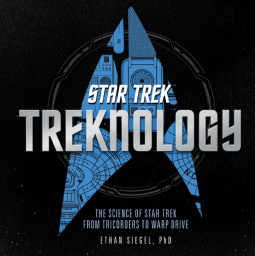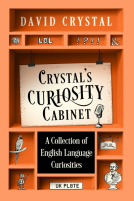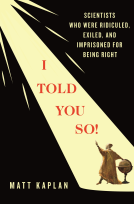
Treknology
The Science of Star Trek from Tricorders to Warp Drive
by Ethan Siegel
This title was previously available on NetGalley and is now archived.
Send NetGalley books directly to your Kindle or Kindle app
1
To read on a Kindle or Kindle app, please add kindle@netgalley.com as an approved email address to receive files in your Amazon account. Click here for step-by-step instructions.
2
Also find your Kindle email address within your Amazon account, and enter it here.
Pub Date Oct 15 2017 | Archive Date Jan 03 2018
Quarto Publishing Group – Voyageur Press | Voyageur Press
Talking about this book? Use #Treknology #NetGalley. More hashtag tips!
Description
The name Star Trek conjures images of faster-than-light spacecraft, holographic crew members, and phasers set to stun. Some of these incredible devices may still be far from our reach, but others have made the leap from science fiction to science fact—and now you can learn the science and engineering of what makes them tick.
Treknology looks at over twenty-five iconic inventions from the complete history of the Star Trek television and film universe. Author Ethan Siegel explores and profiles these dazzling technologies and their role Star Trek, the science behind how they work, and how close we are to achieving them in the real world today.
This stunning collection is packed with 150 superbfilm and television stills, prop photography, and scientific diagrams to pull you into another world. Brace yourself for a detailed look at the inner workings of Star Trek’s computing capabilities, communications equipment, medical devices, and awe-inspiring ships. Treknology is one that no fan of Star Trek, or future tech, will want to miss.
Available Editions
| EDITION | Other Format |
| ISBN | 9780760352632 |
| PRICE | $30.00 (USD) |
| PAGES | 216 |
Average rating from 22 members
Featured Reviews
 Janet P, Reviewer
Janet P, Reviewer
Almost as long as Star Trek has been around their have been books explaining the physics behind the inventions of that universe and speculating on whether they could come to be given the state of our knowledge and know-how.
Trekology is the latest in this series and it both more beautiful and more scientific than most. Lavishly illustrated with photos from the various TV series and movies, the book explores many of the technical devices seen in the franchise.
The book does two things that elevate it above most of these books. First, it tells us the history of these devices within the Star Trek universe, which will be great for Trekkies. Second, it delves into science and technology in a more thorough and thoughtful way.
It's an interesting book.
 Annette J, Reviewer
Annette J, Reviewer
An engaging and entertaining look at the science from Star Trek, and it's real world applications.
Lavishly illustrated with stills from the various Trek television series and films, ranging from The Original Series to the most recent Abrams and Lin films, the book looks not only at how the technology developed over the franchise, but also how it both inspired and was inspired by real life science and technology. Broken down into categories, everything from transporters to photon torpedoes, communicators to tricorders are discussed in a concise and easy to follow way, making the book enjoyable and informative even for those with only the most rudimentary science knowledge. I particularly liked the focus on where current technology stands in comparison to the future envisioned in Trek, and was quite surprised by how advanced the developments are in certain areas such as the transparent aluminum referred to in Star Trek IV: The Voyage Home. While much of the science and technology explored is of course physics based, there is a full chapter devoted to the medical side of things including Geordi's visor and the hypospray, as well as an interesting discussion of the chemistry of synthehol.. This is definitely a book I'd recommend to any Star Trek fan, a great window into how the science fiction of the past has informed the technology of today, and where that technology may boldly go in the future.
 Sarai H, Reviewer
Sarai H, Reviewer
I am a huge Trekkie. Anyone who knows me can attest to that. I grew up with Star Trek the next generation, Deep Space 9, Voyager, Enterprise and now the rebooted Star Trek. I know this genre.
I picked up this book for the pure science of it. The content is so in depth with real situations that correlate with Star Trek technology. We've come so far, and a lot of the things we take for granted on the show, are close to becoming reality. The photos are great and placed throughout the book. The writing was excellent, although a little dry at times.
My ten year old autistic son would love this read. He is all about the science. I will be passing this book along to him.
This would be a great Christmas present for anyone who loves Star Trek and has a thing for science.
Received an advance reader copy in exchange for a fair review.
 Devin K, Reviewer
Devin K, Reviewer
Being a star trek fan I immediately had to check out this book. The technology is amazing and having this book takes not only your knowledge but love for everything that goes into this amazing universe, to the next level. Highly recommend for any fan or fan to be!
 John L, Reviewer
John L, Reviewer
This is a very good look at the science as used in Star Trek (in all its variations), and more importantly what our current level of nous equates to. So while the 3D printer is a long way off knowing which type of cup to serve "tea - early grey - hot" in, we don't have as far to go as we'd fear. Mind you, in so many other regards - FTL travel, instantaneous communication, and so on - we're just flapping a posh salt shaker over someone who might be expecting a full tricorder. It'll teach the average reader a lot of quite advanced physics and chemistry, even while it shows we've advanced in quite special ways in computing and other subjects. Highly pictorial, this is eminently browseable, has a lot of information to teach us, and a positive message. I really liked it.
 Reviewer 298993
Reviewer 298993
Spoiler alert: I'm not a Trekkie, but I still wanted to learn more about the show and what better way than learning the science behind it?! The photos were beautiful and everything was explained in such a way that even I could understand. Kudos to the author for that. This is a great addition for anyone that loves science and science fiction. I would recommend this book. 4.5 out of 5 stars.
A really nice overview of various technologies used in Star Trek, where we are now, and how feasible they could become. Helped me enjoy the show just a bit more.
 Charity H, Reviewer
Charity H, Reviewer
If you like Star Trek then you will like this book. But, if you enjoy science and learning how it connects in real life to sci-fi elements then this is a wonderful book for you too. It is interesting and mentions original Star Trek and Next Gen. the most, but all the characters, movies and shows in the Star Trek world are involved. Pick up this book for some interesting information.
Great nerd coffee table book
I enjoyed this book. I particularly liked how Ethan Siegel compared where Star Trek was and where we are and where we will realistically be. He was unhesitant to label some things as unrealistic while others as attainable. He explained the science clearly and wrote in a fun way. Although i received a digital galley of the book via Netgalley, I was also fortunate to receive a hard copy as a gift and I can safely say that the book is beautiful. The photographs and illustrations are gorgeous to the point where I would say that this is a good coffee-table book. I strongly recommend this book for fans of Star Trek or for anyone interested in science.
Disclosure: I received a complimentary copy of this book via Netgalley for review purposes.
I've long been a fan of Star Trek (favourite series - The Next Generation) and so I jumped at the chance to read this ARC. An interesting look at the science behind the ideas on the franchise, and also at some of the inventions it has inspired, taking in everything from the sliding doors, with that unmistakable shh sound, to warp drive technology - this is a comprehensive guide. Packed with photos from the different show incarnations, except the most recent one, it is a must-read for any Star Trek fan.
My family watched Star Trek every Saturday while I was growing up (mostly teenage years), even though I did not really get into it. I have since learned that I am like one of the only persons in the world that is not a real Trekkie! However, I found this book to be very interesting and fun to read. The writing is excellent and the photographs are wonderful. This book would be a great gift for any Trekkie or even as a coffee table book. I enjoyed it immensely.
 Jonathan A, Reviewer
Jonathan A, Reviewer
I really enjoyed this book, I will say that it goes quite in-depth. Half of what he was saying went over my head but I still thoroughly enjoyed it. Personally I wouldn't try a teleporter. I like my atoms the way they are.
 Ruth F, Educator
Ruth F, Educator
Sci-fi writings have been the dreams and places of inspiration for scientists for years past and this book shows that Star Trek is no different. A look at the items from the show that have or are becoming science fact, this book is well presented and easy to navigate, it goes into depth on some of the more familiar elements from Gene Roddenberry's world. With many, many images to break up the science, this could almost be a coffee table book, definitely recommended.
 Samantha B, Reviewer
Samantha B, Reviewer
This book explores the technology of the Star Trek universe. As I huge Star Trek nerd, I loved this. I think the technology they chose to showcase were well picked, well organized, and the sections were well written. Though, if you don't know Star Trek, you will be fully lost.
Each section is helped by stills and pictures from pretty much every iteration of Star Trek, focusing raining on TOS, TNG and the new movies (having both TOS and new canon stills was a bit weird because you have two faces labeled Captain Kirk etc. but it didn't negatively impact the book).
Some sections were written as if in-universe. With the science behind the technology explained as if it were a real technology. With history and discovery dates etc. which I loved. Other parts left the in-universe and compared the technology to real world technologies etc. and elaborated the role said technology played in a specific Star Trek show. I think it might have benefitted from being one or the other rather than both.
In all, I thought this was a great book, though it would have been much better in person, as the digital edition resolution isn't great or easy to flip through. I recommend this for any serious Star Trek fan.
 Paul M, Reviewer
Paul M, Reviewer
The classic TV and movie series Star Trek, in its many manifestations, is very entertaining on the story-telling merits alone. But the minds behind the stories weren't just weaving fantasies. The technology in Star Trek, even the most fanciful, anticipated and inspired technology that is in our grasp. In Treknology: The Science of Star Trek from Tricorders to Warp Drive, astrophysicist Ethan Siegel demonstrates how dozens of Star Trek technologies have either come into common use, or are being developed.
One of the most ubiquitous is, of course, the cell phone. The original flip phones were modeled after the communicators first used in the original Star Trek series. At the time the series aired, the concept of using a hand-held device for two-way communication over great distances was fantasy. Today we take it for granted. Another iconic show element is the automatic sliding doors. When they appeared on the show, they were amazing. Today we walk through so many of them we rarely notice. We regularly use computers that far surpass anything the show's creators imagined. We use tablet computers that exceed the PADDs on the show, and our devices have so much memory and computing power we don't know what to do with it all.
Some of the other technologies in the show are quite a bit further from everyday usage. The transporter beam, another iconic Star Trek staple, is still almost in the realm of fantasy, but scientists have been developing the ability to transport matter. The warp drive and impulse engines are well out the reach of current application, but are imaginable based on current usage. Other Star Trek technologies, like artificial gravity, antimatter containment, and the Holodeck still seem way out of reach, but Siegel writes that even these fantastic-sounding technologies are in the infancy of actual development. He writes, "We might not have achieved the dream of Star Trek just yet in every regard, but given that it's been just more than a half century since it first envisioned our world three hundred years into the future, our progress isn't too shabby."
Treknology is a fun book, chock full of references to various episodes and movies, with screen shots and scientific illustrations. It's a reminder that phrases and scenes fans know and love, like "What is the nature of your medical emergency?," "Set phasers for stun," and the introduction of transparent aluminum are more than just throwaway plot points, but, like much of the series, are harbingers of things to come.
Thanks to NetGalley and the publisher for the complimentary electronic review copy!
 Educator 317339
Educator 317339
Both Trekkies and science-lovers should enjoy this book. I fall more into the latter; although I've watched some Star Trek, I by no means am familiar with all of it. I was surprised at how the "far-out" type things from Star Trek relate (at least partially) to real-world partial possibilities. For instance, I had no idea that corundum was such an amazing material made of aluminum and oxygen atoms. I think that my older students would enjoy this book, too.
Readers who liked this book also liked:
Alvin E. Roth
Business, Leadership, Finance, Health, Mind & Body, Politics & Current Affairs


















